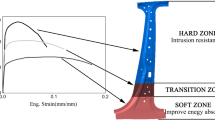Abstract
The aim of this study is to survey and verify the suitable quenching and tempering conditions of SKH51 high-speed tool steel material as a steel grade of AISI M2 for manufacturing an inner race with the six-skewed cross ball grooves used for a constant velocity joint. The longitudinally six-segmentalized asymmetric cold forging die fabricated by the SKH51 with a macro hardness (HRC) of over approximately 66.5 has often been broken and fractured during the cold forging operation, due to the excessive hardness of the tool material. The macro hardness (HRC) and the compressive strength were investigated for obtaining available and applicable properties of the tool material according to the quenching and tempering conditions, which can prevent fracture. Then, the hardness (HRC) was measured as approximately 64.6 for the quenched specimen at 1,150 °C, 62.4 for first tempered one at 550 °C, 61.8 for the second tempered material at 550 °C, and 61.7 for the third one at 540 °C. Using the quenched and tempered specimens, the compressive yield and ultimate strengths were also determined from a series of uniaxial compression tests as about 3,000 and 4,200 MPa, respectively. The hardness-controlled SKH51 material was considered to fabricate the longitudinally segmentalized cold forging die. With the reduced hardness and the measured compressive strength of the SKH51 tool material, the longitudinally six-segmentalized cold forging dies were refabricated and applied to the semi-closed die cold forging process for producing the inner race with the six-skewed cross ball grooves. It is shown that the hardness-controlled SKH51 high-speed tool steel could properly be applied to the inner race cold forging without any fractures, and the validity of the proposed heat treatment history is also confirmed.
Similar content being viewed by others
References
Kamouneh AA, Ni J, Stephenson D, Vriesen R (2007) Investigation of work hardening of flat-rolled helical-involute gears through grain-flow analysis, FE-modeling, and strain signature. Int J Mach Tools Manuf 47:1285–1291
Kroiβ T, Engel U, Merklein M (2013) Comprehensive approach for process modelling and optimization in cold forging considering interactions between process, tool and press. J Mater Process Technol 213:1118–1127
Li XB, Zhang ZM, Wang Q, Yang YB, Li GJ (2014) Forming process optimization for non-axisymmetrical complex component based on FEM simulation and experiment. Int J Adv Manuf Technol. doi:10.1007/s00170-014-5790-y
Faraji G, Jafarzadeh H, Jeong HJ, Mashhadi MM, Kim HS (2012) Numerical and experimental investigation of the deformation behavior during the accumulative back extrusion of an AZ91 magnesium alloy. Mater Des 35:251–258
Lee MC, Chung SH, Jang SM, Joun MS (2009) Three-dimensional simulation of forging using tetrahedral and hexahedral elements. Finite Elem Anal Des 45:745–754
Ku TW, Kim LH, Kang BS (2013) Multi-stage cold forging and experimental investigation for the outer race of CV joints. Mater Des 49:368–385
Ku TW, Kim LH, Kang BS (2014) Process simplification of multi-stage forging for the outer race of a CV joint. Mater Manuf Process 29:85–92
Vazquez V, Altan T (2000) New concepts in die design—physical and computer modelling applications. J Mater Process Technol 98:212–223
Dám K, Vojtěch D (2014) Thermally stable Al-Fe-Mn-based alloy prepared by centrifugal spraying and hot die forging. Mater Sci Eng A 590:232–238
Berns B, Melander A, Weichert D, Asnafi N, Broeckmann C, Groß-Weege A (1998) A new material for cold forging tools. Comp Mater Sci 11:166–180
Zhang G, Yuan G, Jiao G, Li Z, Zhang Y, Liu Z (2012) Microstructure evolution and mechanical properties of T15 high speed steel prepared by twin-atomiser spray forming and thermo-mechanical processing. Mater Sci Eng A 558:566–571
Cui X, Zhao J (2014) Cutting performance of coated carbide tools in high-speed face milling of AISI H13 hardened steel. Int J Adv Manuf Technol 71:1811–1824
Ghasemi-Nanesa H, Jahazi M (2014) Simultaneous enchancement of strength and ductility in cryogenically treated AISI D2 tool steel. Mater Sci Eng A 598:413–419
Ku TW, Kang BS (2014) Tool design for inner race cold forging with skew-type cross ball grooves. J Mater Process Technol 214:1482–1502
Cao B, Lei Y, Ge A, Chen H, Sanada K (2011) Observer-based clutch disengagement control during gear shift process of automated manual transmission. Int J Veh Mech Mobil 49:685–70
Duarte MDR, Martins H (2004) Inner joint forming and pullout simulation using finite element analysis. SAE Int 2004-01-3422
Park J (2005) Multi-roller balls for constant velocity joints: innovative solution for batter mechanical efficiency and durability. SAE Int 2005-01-0875
Miihkinen VTT (1986) Fracture toughness, strain hardening and life of AISI M2 high speed steel taps. Mater Sci Eng 78:45–53
Kaynak Y (2014) Evaluation of machining performance in cryogenic machining of Inconel 718 and comparison with dry and MQL machining. Int J Adv Manuf Technol 72:919–933
Author information
Authors and Affiliations
Corresponding author
Rights and permissions
About this article
Cite this article
Ku, TW., Kang, BS. Hardness-controlled tool fabrication and application to cold forging of inner race with skewed ball grooves. Int J Adv Manuf Technol 74, 1337–1354 (2014). https://doi.org/10.1007/s00170-014-6070-6
Received:
Accepted:
Published:
Issue Date:
DOI: https://doi.org/10.1007/s00170-014-6070-6



